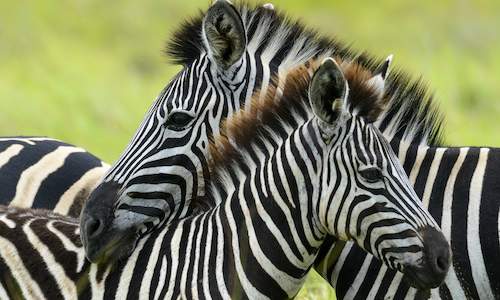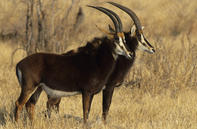
Sable
Name
Sable Antelope [Hippotragus niger]
Appearance
The Sable antelope of South Africa is known for its glossy black coat, white underbelly and striking facial markings. Females and young Sable antelope are dark brown in colours. Both male and females have dorsal manes along the neck and long scimitar horns that curve backwards.
The horns tips are smooth, sharp and pointed. Males grow horns of up to 1.2 m in length, while the female’s horns are shorter and slimmer. The young start growing out their horns at two months old. The shoulder height of bulls is 1.4 m and weigh up to 270 kg. Cows are slightly smaller. The back of the ears is a brick red colour.
Sable Antelope Diet
The Sable antelope is a herbivore and feeds mainly on grasses grown in their habitats within South Africa. They prefer to feed on spear grass, red grass and various species of Brachiaria, Urochloa and Panicum.
They also like to graze on sedge around watering holes. The sable antelope enjoy feeding off climax vegetation, which they crop high above the ground. They are also known to chew the bones of carcasses to fight off phosphorous deficiencies.
Sable Antelope Breeding
The Sable antelope females become sexually mature at three years of age, and will birth their first calf around this time too. The gestation period for the Sable antelope is 270 days, after which a single a calf is born.
Calves weigh in at 17 kg at birth. The new-born calves are hidden in the tall grasses for a period of two weeks, where their mothers will suckle and groom them.
In South Africa, the calves are usually weaned at eight months and start showing an interest in grass from a young age.
Sable Antelope Behaviour
The Sable antelope is gregarious with a variety of herd sizes that can be found across the plains of South Africa. During the breeding season, cows will separate from the larger herds that consist of young and non-breeding individuals.
During the late winters of South Africa, the large herds can be seen gathering around burnt or moist vlei areas. The older territorial males will evict the younger bulls from the breeding groups once they are three years old and sexually mature.
Sable Antelope Habitat
The Sable antelope inhabit open savannah woodlands or moist vlei areas found within South Africa. These areas are chosen for the abundance of medium height grass.
Where They Are Found
The Sable antelope is a rare and endangered species, and their distributional stronghold can be found in the Kruger National Park in South Africa.
The Sable antelope can also be found in other conservation areas where populations have been newly introduced or re-introduced.
Spoor Description
The Sable Antelope's spoor is very much similar to the Roan Antelope, although the Sable’s is much smaller and narrower.

Learning about the mammals of South Africa is now so much easier for all South Africans - SouthAfrica.co.za is an excellent source of inform...
more
 Learning about the mammals of South Africa is now so much easier for all South Africans - SouthAfrica.co.za is an excellent source of inform...
Learning about the mammals of South Africa is now so much easier for all South Africans - SouthAfrica.co.za is an excellent source of inform...